We are in the thick of the dog days of summer, which I always took to mean the hottest days of the year (when it actually refers to the position of Sirius, the Dog Star). The Romans believed that when Sirius and the sun occupied the same region of the sky, Sirius contributed to the sun’s heat (and explained, to them, why this stretch of summer was blazing hot). Stay hydrated, bug hunters! And don’t forget, plenty of bugs like to rest in the shade too.

White-spotted Sawyer Beetle
Monochamus scutellatus
This long-horned beetle is found in coniferous forests across North America, particularly the northern United States, upper Midwest, and much of Canada. Males are black with one white spot at the front of the elytra (wing covers). Females have other white spots throughout the lower portions of the elytra. The males ‘ absurdly long antennae – sometimes twice their body length – help them track down a mate. Wood-boring beetles have a bad reputation due to their effect on the logging industry, but Monochamus spp. play a significant role in nutrient cycling in forest ecosystems, particularly after a forest fire.
Sue Lowery, July 10th, 2023. Thompson Falls, MT.
Leafy Spurge Hawkmoth
Hyles euphorbiae
These large hawkmoths (sphinx moths) are a non-native species that were released in the fight against leafy spurge (the food source for their beautiful caterpillars, shown here). As the first biological agent to combat leafy spurge, these moths have inhabited the United States since 1965. The caterpillars are striking, with colors ranging from vivid green and yellow to dark red, orange and grey, depending on the caterpillar’s age. As adult moths, their wingspan can reach close to 10 cm, and like many day-flying moths, are often mistaken for hummingbirds.
Sue Lowery, July 10th, 2023. Thompson Falls, MT.
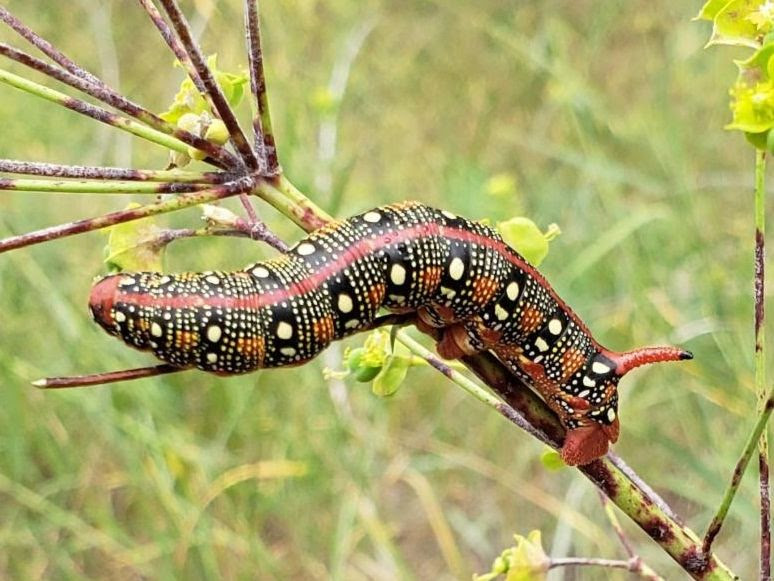
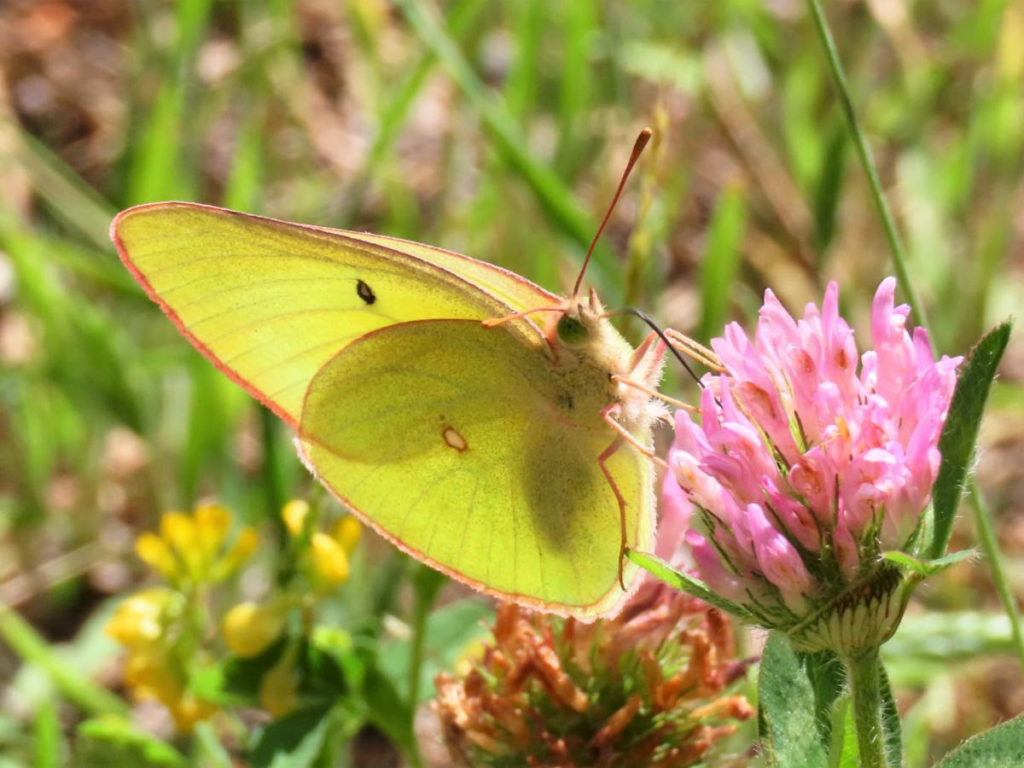
Pink-Edged Sulpher
Colias interior
It’s easy to see where this striking yellow butterfly gets its name. Their fluorescent yellow wings are framed in a stark outline of hot-Barbie pink; they practically look like they were colored with highlighter pens. This species ranges across the northern states and southern Canada, from eastern Oregon to northern New England. There is an isolated population found in the Appalachians as well. With only one flight period per year (June to August), the window is limited to see them. Adult females lay eggs on blueberry plants, which their larvae feed on once they hatch.
Kelly Dix, July 12th, 2023. Rattlesnake Recreation Area, Missoula, MT.
Masked Hunter
Reduvius personatus
Masked Hunters are assassin bugs, a group of true bugs that use a pointed beak to impale and consume their prey. It goes without saying that they can deliver a painful bite to any unsuspecting humans. While the adults are black, the bodies of the nymphs are covered with sticky hairs. They use the hairs to “mask” themselves with a coating of dust, lint, or whatever debris is nearby, giving them the appearance of a dust bunny. But don’t be fooled; even the nymphs are capable of a painful poke.
Connie Geiger, July 15th, 2023. Spokane Hills, Helena, MT.
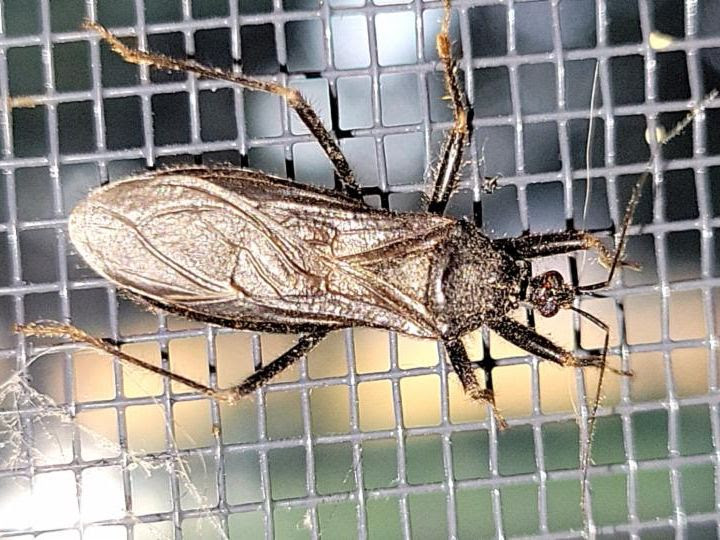

Horned Spanworm
Nematocampa resistaria
These funky-looking caterpillars can be found across much of the US, except for the southwestern states. Since they are found across a wide range, the caterpillars are capable of feeding on many hardwood and softwood species of shrubs and trees including pine, hemlock, fir, larch spruce, alder, ash, birch, and more. While they may have more than one brood a year in other (warmer) parts of the country, there is only one generation here in MT.
Connie Geiger, July 15th, 2023. Spokane Hills, Helena, MT.
Robber Fly
Stenopogon inquinatus
Robber flies (also called “assassin flies”) are speedy ambush predators that prey on other insects, usually snatching them mid-flight. They are commonly found in open, dry, sunny areas; their larvae develop in soil or rotting wood and are voracious predators themselves. This group of flies is not well-studied, despite there being ~7,500 described species worldwide. Despite their predatory nature, they do not bite or go after humans, unlike the better-known (and widely hated) horseflies.
Kelly Dix, July 12th, 2023. Rattlesnake Recreation Area, Missoula, MT.
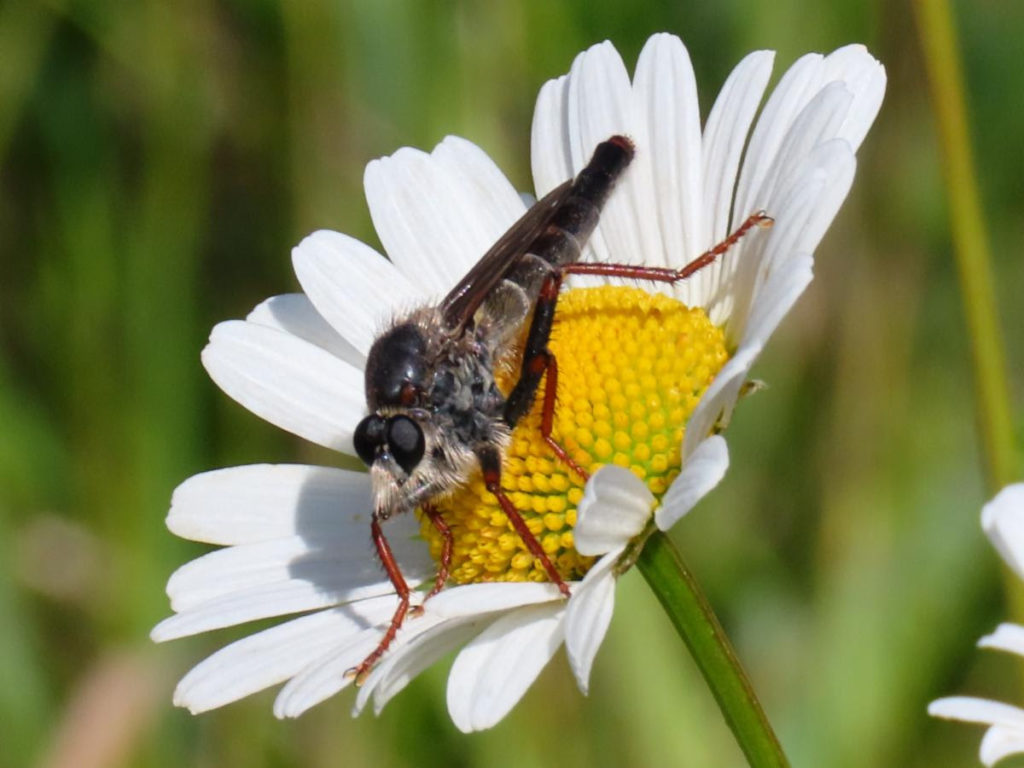

Green Lacewing Larva
Chrysoperla sp.
Lacewings are delicate and fragile-looking insects, yet they are skilled predators who always seem to be on the hunt for food. Despite their voracious appetite, they pose no threat to humans and are a welcome sight for gardeners. They prey on insects that are considered pest-species and are often sold at garden centers as a form of biological pest control. Their larvae (shown here) are referred to as “aphid lions,” who occasionally gather the remains of their prey on their backs or hide under debris for camouflage.
Connie Geiger, July 15th, 2023. Spokane Hills, Helena, MT.
Cherry-faced Meadowhawk
Sympetrum internum
The cherry-faced meadowhawk is one of Montana’s most common and widespread meadowhawk species. Adult females are often seen ovipositing eggs in damp, marshy fields in late summer, usually in spots they know will fill with water in the spring (unfortunately, they are sometimes fooled by freshly-watered lawns). Like all dragonfly species, the nymphs (naiads) begin life in an aquatic state, feeding on aquatic insects and fish. Adult meadowhawks are fast, flighty, and skillful aviators (the fact that this individual was caught by one of our young bug campers is impressive, to say the least).
Brenna Shea, July 17th, 2023. Missoula, MT.
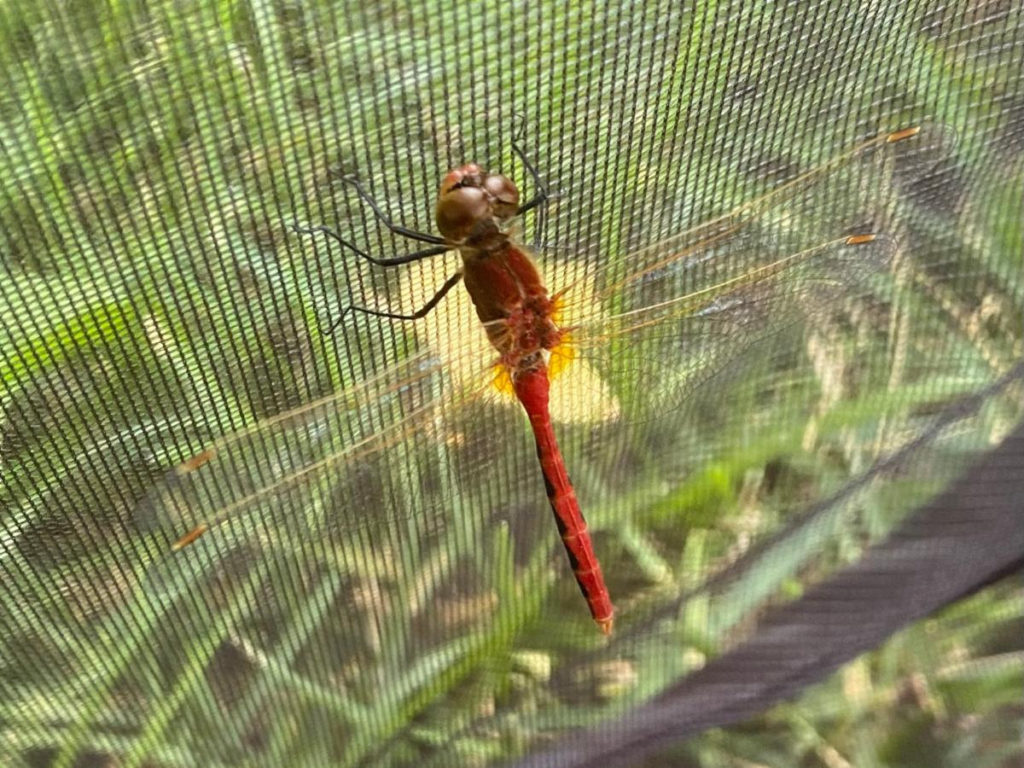

Poplar Borer
Saperda calcarata
The species name for this medium-sized (18-30 mm) boring beetle, calcarata, means “having a spur,” and references the small, pointed spurs on the tips of its hardened forewings (elytra). The poplar borer larvae are notorious forest pests, boring their way into aspen and cottonwood trunks and causing considerable damage. They are found scattered throughout North America, as far north as southern Canada.
Joe Keimig, July 16th, 2023. Missoula, MT.
Western Black Widow
Latrodectus hesperus
This female black widow is certainly beautiful… but take that red hourglass marking on her underside as a warning. While they are not aggressive (will not attack you), they will defend themselves or their egg sacs if you mistakenly grab or step on them. They have incredibly strong venom and a painful bite. Symptoms include: pain in the chest / abdomen, muscle cramping and spasms, difficulty breathing, nausea, chills, a severe increase in blood pressure, and more. A beautiful spider that is best left alone.
Dale Woolhiser, July 15th, 2023. Huson, MT.


Gray Hairstreak
Strymon melinus
This relatively small butterfly (about 20-30 mm) is found across North and Central America in a wide variety of habitats. They are truly cosmopolitan, ranging from cities to farmlands, tropical forests to mountains. They physically resemble the group of butterflies known as the blues but belong to a separate subfamily, Theclinae. They are recognized by the orange and blue spots near the delicate tail-like extensions on their hind wings.
Misty Nelson, July 15th, 2023. South Hills, Missoula, MT.
Eight-Spotted Skimmer
Libellula forensis
This medium-sized dragonfly reaches a length of about 2 inches. They are found west of the Rockies in Canada and the U.S., inhabiting a variety of lakes, ponds, and sloughs. Unlike many dragonfly species, Eight-spotted Skimmers can also be found away from water in upland areas and clearings.
Kelly Dix, July 16th, 2023. Lee Metcalf Wildlife Refuge, Stevensville, MT.


Sharptail Bee
Coelioxys sp.
Sharptail bees go by another common name: the cuckoo leafcutter bees. These cuckoo bees (belonging to the same family as the leafcutters they parasitize) use the pointed end of their abdomen to break into leafcutter nests and do what cuckoos do best: they lay their eggs in the nest and let someone else provision and rear their young. Because they do not need to collect pollen for their offspring, these bees lack the pollen-collecting scopa on the underside of their abdomen but otherwise superficially resemble leafcutter bees.
Misty Nelson, July 14th, 2023. South Hills, Missoula, MT.
Woodland Skipper
Ochlodes sylvanoides
These small, tawny orange butterflies start to emerge in mid to late summer and can be found in just about any habitat; including sagebrush, woodland clearings, gardens, and small streams. Caterpillars overwinter in their first-stage and continue feeding on a variety of grasses in the spring. They then go through a sort of summer hibernation (diapause) as a full-grown caterpillar until it’s time to transform. Woodland skippers can be found from British Columbia south to southern California; east to Montana, Colorado, and Arizona.
Glenn Marangelo, July 15th, 2023. Missoula, MT.

Header Photo: Two-Tailed Swallowtail (Papilio multicaudata) Glenn Marangelo, July 14th, 2023. CSKT Bison Range, Charlo, MT.